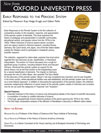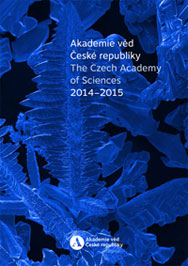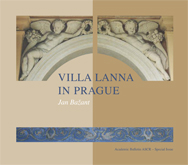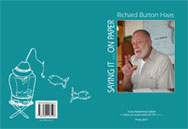The Czech members of the Cracow Academy of Arts and Sciences (1872-1918)
8 Jun 2015
 Lecture by professor Halina Lichocka, Polish Academy of Sciences, about the participation of Czech scientists in the activities of the Academy of Sciences in Krakow, presented on 28 May 2015 at the National Technical Museum in Prague.
Lecture by professor Halina Lichocka, Polish Academy of Sciences, about the participation of Czech scientists in the activities of the Academy of Sciences in Krakow, presented on 28 May 2015 at the National Technical Museum in Prague.
A hand-written rescript of His Imperial and Royal Apostolic Majesty Franz Joseph I sparked off the preparatory works aimed at establishing an Academy of Sciences in Cracow. The rescript, written down in Vienna on May 2, 1871, was addressed to the Minister of Education Josef Jireček. The Emperor`s letter read as follows: « …My wish is to establish an Academy of Arts and Sciences in Cracow. I order you to be so kind as to start negotiations with the Cracow Scientific Society […], negotiations that will lead to the transformation of the Society into such an academy. I am awaiting respective motions to decide on them ».
The new booklet by the Association of Moravian institutes of the Czech Academy of Sciences
5 Jun 2015
The Association of Moravian institutes of the Czech Academy of Sciences that consists of the CAS institutes based in Brno and Ostrava and institutes that have detached units in Brno, Ostrava and the South Moravian Region, has prepared the well-arranged and detailed booklet with the information about the all CAS institutions in the Moravian region. You can download it here.
The Association of Moravian institutes of CAS was created by the Treaty of directors of institutions involved in the CAS on April 15, 2013. However, its roots are deeper, dating back to the Association of CAS Institutes founded on November 21, 2002. The aim of the association consists in particular in presentation, promotion and popularization of nonuniversity type of science and training in the basics of scientific work. It also seeks to coordinate interdisciplinary projects in CAS institutions in the Moravian region, it contributes to mutual awareness, cooperation and assistance to member institutes in organizational matters, consulting their common challenges and problems and presenting proposals and demands to the academy-level and other authorities. It also represents the member institutions with the municipal authorities of Brno and Ostrava, the South Moravian and Silesian Region, universities and media in the region.
EFORT Congress in Prague
27 May 2015
Infections following joint-replacement surgeries: Europe’s orthopaedic experts consult on how to optimize prevention and therapy strategies
For all the advances being made in this discipline, postoperative infections remain a great challenge for orthopaedists and trauma surgeons. More than 7,000 experts from around the globe are gathering in Prague for the 16th EFORT Congress to consult on ways to optimise prevention and therapy for these dreaded complications. More information https://www.efort.org/prague2015/.
The Mendelianum focuses on Mendelian genetics
20 Apr 2015
Scientific progress the past 150 years is highlighted in a new permanent exhibition at the Mendelianum Visitor Centre in Brno. Its focus is the publication in 1865 of Experiments in Plant Hybridization by Johann Gregor Mendel, the “Father of Genetics” and a world class scientist. The Mendelianum Centre is located on the premises where Mendel’s scientific society held its meetings. Visitors are given an insight into the world of genetics and molecular biology. The Mendelianium is a well-equipped laboratory that enables visitors to engage in numerous methods and laboratory techniques from the pollination of pea flowers to gene expression. This project aims to strengthen public interest in research in genetics and molecular biology and reveals the practical and social impact of discoveries in these two major areas.
The Next Horizon of Technology Assessment
12 Mar 2015
The PACITA network, a network of TA institutions from across Europe, held its second European TA conference under the motto "The Next Horizon of Technology Assessment", aiming at taking stock of and supporting exchange on TA capacities available in Europe. The conference brought together for three days in Berlin a broad and diverse range of TA experts and others interested in critically reflecting the role of technology in society. They shared knowledge and experiences with various practices of technology assessment such as cross-disciplinary expert studies, stakeholder involvement, citizen consultation and parliamentary discourse, stimulating mutual learning of TA practitioners and researchers. The conference was organized by Karlsruhe Institute of Technology (ITAS/KIT) and the Technology Centre of the Academy of Sciences of the Czech Republic. More about project – http://berlinconference.pacitaproject.eu/
Work of Soňa Štrbáňová in Early Responses to the Periodic System
3 Mar 2015
 Oxford University Press recently published the work of Soňa Štrbáňová from the Institute for Contemporary History of the Academy of Sciences of the Czech Republic in the monograph Early Responses to the Periodic System. It is a comprehensive and timely reference. Oxford has generously arranged to make Early Responses to the Periodic System available to “friends and family” of the work at a special price for a limited time. You will receive 30% off the list price of $35.00! For more information or to take advantage of this exclusive discount, please visit https://global.oup.com/academic/help/ordering/?cc=cz&lang=en& and type promotion code: ASPROMP8 at check out.
Oxford University Press recently published the work of Soňa Štrbáňová from the Institute for Contemporary History of the Academy of Sciences of the Czech Republic in the monograph Early Responses to the Periodic System. It is a comprehensive and timely reference. Oxford has generously arranged to make Early Responses to the Periodic System available to “friends and family” of the work at a special price for a limited time. You will receive 30% off the list price of $35.00! For more information or to take advantage of this exclusive discount, please visit https://global.oup.com/academic/help/ordering/?cc=cz&lang=en& and type promotion code: ASPROMP8 at check out.
New Vice Presidents and members of the ERC Scientific Council
17 Feb 2015
Following their election by the Scientific Council, Professors Sierd Cloetingh and Mart Saarma have been appointed new Vice Presidents of the European Research Council. This news was coupled with the European Commission's appointment today of three new members of the Scientific Council: Prof. Dame Janet Thornton, Prof. Fabio Zwirner and Head of the Department of Spintronics and Nanoelectronics Institute of Physics, Academy of Sciences of the Czech Republic & Professor at School of Physics and Astronomy University of Nottingham Prof. Tomáš Jungwirth.
The Academy of Sciences celebrates its 125th Anniversary
8 Jan 2015
 On January 23, 2015, The Academy of Sciences of the Czech Republic celebrates 125th Anniversary of establishment of Emperor Franz Josef’s Czech Academy for Sciences, Literature and the Arts – its own ancestor that became in 1952 together with other scientific institutes the pedestal for Czechoslovak Academy of Sciences.
On January 23, 2015, The Academy of Sciences of the Czech Republic celebrates 125th Anniversary of establishment of Emperor Franz Josef’s Czech Academy for Sciences, Literature and the Arts – its own ancestor that became in 1952 together with other scientific institutes the pedestal for Czechoslovak Academy of Sciences.
Je suis Charlie
7 Jan 2015
 In the solidarity with other European states opposed to all terrorist attacks, the Czech Academy of Sciences expresses its condolences for the victims of the outrages in France January 2015.
In the solidarity with other European states opposed to all terrorist attacks, the Czech Academy of Sciences expresses its condolences for the victims of the outrages in France January 2015.
Unique collection of wine has been put at 20 million Kč
31 Dec 2014
 After the St Maurus reliquary, that is a national cultural monument and one of the greatest treasures of the Czech Republic, the Bečov castle takes pride in unique collection of 136 bottles of wine, cognac and Champagne that mostly originate from the 1890s. The value of old bottles that were uncovered together with the medieval St Maurus reliquary in the Bečov nad Teplou castle in 1985 has been put at 20 million Kč. Many bottles in collection have preserved labels therefore, it can be determined not only the origin but also the concrete wine grower who produced the wine and the dealer who sold it. Each bottle has a value of minimum 200,000 Kč and it is probably the most valuable find of wine in the Czech Republic. The treasure is kept in a special depository at the Bečov castle.
After the St Maurus reliquary, that is a national cultural monument and one of the greatest treasures of the Czech Republic, the Bečov castle takes pride in unique collection of 136 bottles of wine, cognac and Champagne that mostly originate from the 1890s. The value of old bottles that were uncovered together with the medieval St Maurus reliquary in the Bečov nad Teplou castle in 1985 has been put at 20 million Kč. Many bottles in collection have preserved labels therefore, it can be determined not only the origin but also the concrete wine grower who produced the wine and the dealer who sold it. Each bottle has a value of minimum 200,000 Kč and it is probably the most valuable find of wine in the Czech Republic. The treasure is kept in a special depository at the Bečov castle.


 Česky
Česky














